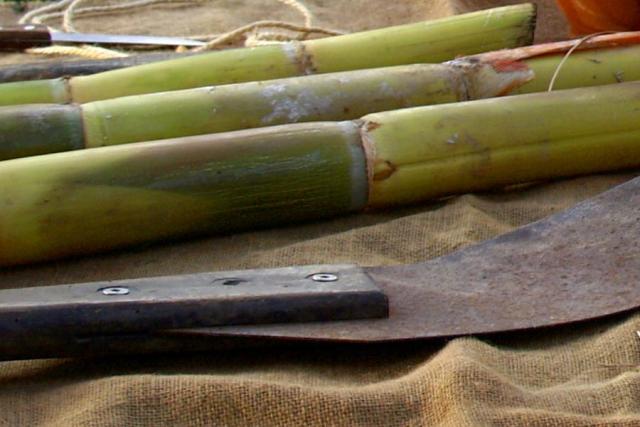The first historical reference of Motril as a town dates back to the Kingdom of Granada. Much of the Muslim influence can be seen today on place names, its agricultural plain, irrigation canals or the introduction of sugar cane before the 10th Century.
It is important to highlight that it was Motril the city which exported sugar cane to America and not the other way around as it is thought. Moreover, it is necessary to mention that this “sweet gold” has been grown in Motril for 1.200 years and therefore, the town, its culture and landscape have been connected to the exploitation and production of sugar cane.
Sugar cane has been for more than 1.000 years an important source of income with a substantial impact on our economy. Although the last sugar cane harvest was in 2006, there are still people who dream about our agricultural plain to shine again in all its glory. Actually, this activity has not ceased completely with farmers resuming sugar cane harvest operations.
This sweet gold route will allow both citizens and visitors to get to know more about our architectural heritage, cultural legacy and our long tradition in sugar cane that led Motril to become the capital of this product in Europe.
It provides a much wider view of the history of Motril through its relationship to sugar cane; a crop that led Motril to grow at a steady pace being one of the main sources of wealth coveted by both tax collectors and pirates. In the early 19th Century, it also provided an industrial fabric which had a powerful economic influence in the rest of the province.
Old sugar factories scattered along the coastline bear the silent testimony of our industrial past and design a tour that will allow the visitors to discover the glorious past of the town.
We will begin by visiting the Pre-industrial Sugar Cane Museum and then the Montero Rum Distillery.
Pre-Industrial Sugar Cane Museum
The "Pre-industrial Sugar Cane Museum” was restored from the latest archaeological remains of what had been one of the most important sugar factories in Motril from the late Middle Ages to the last years of the Modern Age: the Ingenio de la Palma.
The sugar factory of La Palma, whose first mention dates back to the late 15th Century, was a sugar factory with horizontal mills to crush the sugar cane. However, it is possible that, at some point in the beginning, round milling-stones or edge runners could also be used to mould sugar cane. As time went by, the structure disappeared almost entirely, except for the house, and with the passing of centuries this former sugar factory fell into oblivion.
In 1989, due to a levelling project undertaken to the rear of La Palma house, very large carved stones were discovered; one of them with three channels and one with a circular channel. This fact, led to consider the relationship between those elements and the old sugar factory. For this reason, it was carried out an excavation led by the Prof. Malpica where different walls and components of the sugar factory were discovered. Thanks to the discovery of these archaeological remains, the Town Hall decided to begin the restoration process.
The project was undertaken by the architect Federico Salmerón and was financed by the Regional Ministry of Tourism of the Government of Andalusia. The restoration work started at the end of 1996 and it was completed by the autumn of 1998.
The Association of Municipalities of the Tropical Coast was responsible for the equipment of the Pre-industrial Sugar Cane Museum. The project started in 2000 and it was completed in December, 2002.
This place is well worth a visit because it is one of a kind museum in Europe which will allow the visitor to get to know more about the sugar cane activity in Motril. Sugar cane was one of the most important pre-industrial activities from Muslim times. Nowadays, this activity has not ceased completely with farmers resuming sugar cane harvest operations.
This Pre-industrial museum was included in the RECTA Association (Andalusian Network of Scientific and Technical Divulgation Spaces) together with the Science Park of Granada, the Botanical Garden and the Ethnobotanical Museum of Córdoba among others.
Address: Avda. Marquesa de Esquilache, 4
18600 Motril GR
Telephone number: 958 822206
Email: museodelazucar@motril.es
Web:
www.motrilturismo.com/es/patrimonio-y-monumentos/museo-preindustrial-del-azucarOpening hours: Tuesday to Saturday from 10 to 14 & 16 to 19h. Sunday from 10 to 13:30 h.
Admission fee: 3€. Young and retired people: 2€. Group of a minimum of 20 people: 2€
Rum Montero Distillery
This building closes the circle of this tour where the visitors will have the opportunity to see and to taste our local rum made from the sugar cane. Rum Montero is a company from the province of Granada.
It was founded in 1963 by a family which has been cultivating sugar cane for generations, whose guiding principles have always been quality of its products and artisanal production techniques, the laying of enormous importance on the quality of raw materials used, and scrupulous respect for the Crianza times in the system of “Soleras” and “Criaderas”.
Today Rum Montero sells 240.000 litres of rum a year and its citizens, together with those who have had the opportunity to try this rum, are its most enthusiastic ambassadors. This tour takes about 1 hour. At the end of your visit, you will have the possibility to taste the final product.
Address: Camino de la Vía s/n (Ctra. De la Celulosa)
18613 Motril GR
Telephone number: 958 600183
Email: info@ronmontero.com
Web:
www.ronmontero.comOpening hours: The distillery offers free guided tours to the public from Tuesday to Saturday at 13.00 h in English. Alternatively, you can contact us by email or by phone.
Free admission

